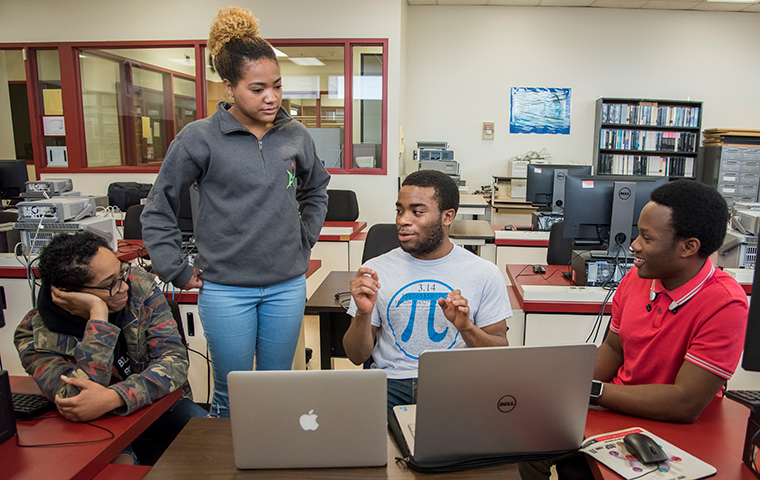
Assembling a Village
Naeem Turner-Bandele '18
Electrical engineering student Naeem Turner-Bandele ’18 looks to the hidden histories of the past to find inspiration and motivation to help shape the future.
“What enables African Americans to remain focused and motivated in a society that does not recognize the contributions of African Americans?”
That compelling question was first asked by editors Raymond Webster and Dr. Wesley Harris in African American Firsts in Science & Technology, their one volume overview of the scientific and technical contributions of African Americans throughout the history of the United States.
In my own life, I am driven by and find strength in their question. And how would I answer them? By saying this: I can remain focused and motivated on my path because people past and present form a village around me. My parents assembled this village and it teaches me how to look to the past and then to the future despite any societal challenges that exist in the present.
In looking to the past and then to the future, I am inspired by the great African American scientists, mathematicians, inventors, and engineers of the past whose unparalleled accomplishments often went unrecognized. People like Alexander Miles, who invented the modern elevator design, or Sarah Boone, who created an improved ironing board. Phillip Downing designed a switching system for railroads that guided trains along a track, and then he invented the street letterbox. And Marie Van Brittan Brown and her husband Albert invented the home security system.
These inventions remain part of our everyday life, but the stories of these brilliant African Americans have remained conspicuously absent from mainstream history. In many cases, their stories have been deliberately discarded, continuing a false narrative that says, “African Americans cannot and have not contributed anything of value to American society outside of sports and entertainment.” In other cases, the absence of these stories in everyday life is simply a byproduct of being African American during a time when there were so few opportunities to claim credit for our work.
Fortunately, I have a village that believes it is imperative that I know their concealed history as well as the mainstream history. The value of knowing this concealed history has been so important to me as I pursue my own degree in a mostly homogenous discipline. Even when I sit in a class as the sole representative of my racial group, I rarely feel alone or discouraged. Instead, I am buoyed up by the brilliance and perseverance of those who came before me and on whose shoulders I stand.
The great African American scientists and inventors of the past are more than inspirations for me; they are my fuel. Because so many have been ignored, my own success is imperative to bridge the past, present, and future—to shine a light on the concealed history of their accomplishments through my accomplishments. I know that as I succeed, I will be able to tell their stories so that they may finally get the recognition they deserve. I owe my African American predecessors nothing less since they’ve paved the path forward for me.
As a future African American engineer, I want to do one more thing. I want to do what those who came before me sought to do—improve the human condition—and leave the planet better than it was when they arrived. My responsibility to be a role model and mentor—today as a student—is not something I take lightly. I have no intention of shirking my responsibility after earning my degrees. In fact, my life mission is to create technological products and services that are accessible, affordable, efficient, and that meet the needs of all human beings.
By doing my part, being a member of the village for others, I can help set the stage so that the next generation believes like I do, that they too can be Black and brilliant. By doing my part, I can help show the connection between past and future so that those who came before me will no longer be forgotten or only considered during Black History Month.
Naeem Turner-Bandele is a junior at Santa Clara University majoring in electrical engineering, President of the NSBE chapter, and the author of “What Are We Gonna Do Today?”. This article first appeared in a different format in USA Today College.
Kamilah Prentice ’18, Hannah LeBlanc ’18, Uche Agwu ’18, and Naeem Turner-Bandele ’18 discuss their Benson Center E-Week installation, “Black & Brilliant: A Timeline of Inventions.” Photo by Joanne Lee